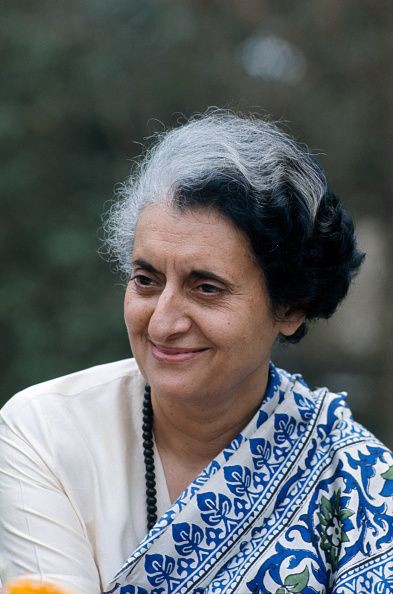
The Saree as a Statement: How Political Leaders and Activists Use the Saree to Make a Point
Share
The saree is more than just a garment. For centuries, it has been a symbol of grace, tradition, and cultural identity. However, for many women in politics and activism, the saree also serves as a powerful statement—an emblem of strength, defiance, and unwavering resolve.
In a world where fashion often intertwines with personal branding, women who don the saree in the political arena aren't just choosing a traditional outfit. They are making a deliberate choice to embrace their heritage while sending a message of empowerment. Let's explore how the saree has been used as a political tool by influential women to express their identity, values, and beliefs.
1. Indira Gandhi: The Power of Simplicity
As India’s first and only female prime minister, Indira Gandhi wielded enormous influence both domestically and internationally. Her choice of attire was almost always the saree, but it wasn't just any saree—it was often a simple, understated cotton or silk saree that spoke volumes about her leadership style. She wore the saree as a symbol of her connection to the common people, even while occupying the highest political office in the country.
Gandhi’s use of the saree also reinforced her status as a figure of both power and humility. The saree became part of her legacy, a visual representation of her commitment to India and its heritage. Whether addressing farmers in rural India or global leaders at international summits, Gandhi’s saree made her both relatable and formidable.
2. Sonia Gandhi: Carrying Forward the Legacy
Sonia Gandhi, a prominent figure in Indian politics and the Congress Party leader, continues the tradition of using the saree as a mark of identity and solidarity with Indian culture. Her fashion choices, often traditional handloom sarees, pay homage to the diverse textile heritage of India. Whether campaigning or making public appearances, Sonia Gandhi’s sarees often have symbolic value—supporting weavers, promoting local crafts, and standing by the cultural legacy of India.
For her, the saree has become not just a garment, but a continuation of a legacy of strong, influential women in Indian politics.
3. Mamata Banerjee: The Voice of the Masses
Mamata Banerjee, the fiery Chief Minister of West Bengal, is another prominent leader who uses the saree as a powerful statement. Known for her simple white cotton sarees with blue borders, Banerjee’s sartorial choices reflect her commitment to the grassroots. Her unpretentious style resonates with the working class, and her sarees symbolize her dedication to serving the people.
Banerjee’s sarees project humility, but her politics are anything but. She is known for her fierce independence and strong will, and her simple saree has become a reflection of her relentless pursuit of justice for the underprivileged.
4. Kiran Bedi: The Saree as a Symbol of Defiance
India’s first female police officer and a social activist, Kiran Bedi, is known for breaking barriers throughout her career. Her saree choices, often crisp cotton or khadi, are a nod to the values of discipline and integrity she upholds. For Bedi, the saree is not just a symbol of tradition but also a reflection of her tough, no-nonsense approach to leadership.
Bedi has often spoken about the saree as an empowering garment for Indian women, not just in political or social spaces, but in everyday life. Her message is clear: a saree-wearing woman can be as fierce, determined, and capable as anyone else.
5. Medha Patkar: The Saree as a Symbol of Resistance
Medha Patkar, the prominent social activist and founder of the Narmada Bachao Andolan, has used the saree as a symbol of her struggle for environmental justice. Often seen in simple handwoven sarees, Patkar’s attire reflects her deep-rooted connection with the rural communities she fights for. Her sarees serve as a reminder that she stands with the marginalized, embodying a sense of humility and resistance against corporate and government exploitation of natural resources.
For Patkar, the saree is a cultural identifier, aligning her with the indigenous communities who also wear the garment. In a sense, it is a mark of solidarity, reinforcing the idea that she stands shoulder to shoulder with those she seeks to protection.
6. Priyanka Gandhi Vadra: Reimagining Modern Leadership
Priyanka Gandhi Vadra, the rising political leader of the Congress Party, has modernized the use of the saree in Indian politics. Often seen in bold colors, contemporary designs, and handloom fabrics, her sarees exude confidence and power. Priyanka blends tradition with modernity, presenting herself as a leader rooted in India’s past but looking towards the future.
Her choices often reflect regional craftsmanship, paying homage to India’s weavers while making a political statement that embraces inclusivity and cultural diversity.
The Saree: A Statement of Identity, Power, and Resistance
Throughout history, the saree has been a powerful tool for Indian women leaders. It symbolizes their connection to tradition, culture, and the masses, while also serving as an emblem of resistance and strength. For many, the saree is not just a garment—it is a political and social statement, a way to express who they are and what they stand for.
As these women demonstrate, wearing a saree in politics or activism is a deliberate choice. It communicates identity, values, and often a defiance against the expectation to conform to Western standards of dress. In a world of power suits and blazers, the saree remains a timeless reminder that true power often lies in embracing one’s roots.